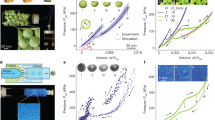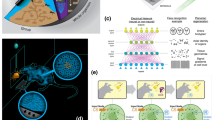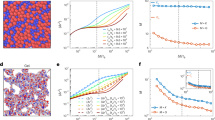Abstract
Spontaneously flowing liquids have been successfully engineered from a variety of biological and synthetic self-propelled units1,2,3,4,5,6,7,8,9,10,11. Together with their orientational order, wave propagation in such active fluids has remained a subject of intense theoretical studies12,13,14,15,16,17. However, the experimental observation of this phenomenon has remained elusive. Here, we establish and exploit the propagation of sound waves in colloidal active materials with broken rotational symmetry. We demonstrate that two mixed modes, coupling density and velocity fluctuations, propagate along all directions in colloidal-roller fluids. We then show how the six material constants defining the linear hydrodynamics of these active liquids can be measured from their spontaneous fluctuation spectrum, while being out of reach of conventional rheological methods. This active-sound spectroscopy is not specific to synthetic active materials and could provide a quantitative hydrodynamic description of herds, flocks and swarms from inspection of their large-scale fluctuations18,19,20,21.
This is a preview of subscription content, access via your institution
Access options
Access Nature and 54 other Nature Portfolio journals
Get Nature+, our best-value online-access subscription
$29.99 / 30 days
cancel any time
Subscribe to this journal
Receive 12 print issues and online access
$259.00 per year
only $21.58 per issue
Buy this article
- Purchase on Springer Link
- Instant access to full article PDF
Prices may be subject to local taxes which are calculated during checkout



Similar content being viewed by others
References
Schaller, V., Weber, C., Semmrich, C., Frey, E. & Bausch, A. R. Polar patterns of driven filaments. Nature 467, 73–77 (2010).
Sanchez, T., Chen, D. T. N., DeCamp, S. J., Heymann, M. & Dogic, Z. Spontaneous motion in hierarchically assembled active matter. Nature 491, 431–434 (2012).
Wioland, H., Woodhouse, F. G., Dunkel, J., Kessler, J. O. & Goldstein, R. E. Confinement stabilizes a bacterial suspension into a spiral vortex. Phys. Rev. Lett. 110, 268102 (2013).
DeCamp, S. J., Redner, G. S., Baskaran, A., Hagan, M. F. & Dogic, Z. Orientational order of motile defects in active nematics. Nat. Mater. 14, 1110–1115 (2015).
Nishiguchi, D., Nagai, K. H., Chaté, H. & Sano, M. Long-range nematic order and anomalous fluctuations in suspensions of swimming filamentous bacteria. Phys. Rev. E 95, 020601 (2017).
Ellis, P. W. et al. Curvature-induced defect unbinding and dynamics in active nematic toroids. Nat. Phys. 14, 85–90 (2017).
Deseigne, J., Dauchot, O. & Chaté, H. Collective motion of vibrated polar disks. Phys. Rev. Lett. 105, 098001 (2010).
Bricard, A., Caussin, J.-B., Desreumaux, N., Dauchot, O. & Bartolo, D. Emergence of macroscopic directed motion in populations of motile colloids. Nature 503, 95–98 (2013).
Chen, Q., Bae, S. C. & Granick, S. Directed self-assembly of a colloidal kagome lattice. Nature 469, 381–384 (2011).
Kumar, N., Soni, H., Ramaswamy, S. & Sood, A. K. Flocking at a distance in active granular matter. Nat. Commun. 5, 4688 (2014).
Nishiguchi, D. & Sano, M. Mesoscopic turbulence and local order in janus particles self-propelling under an ac electric field. Phys. Rev. E 92, 052309 (2015).
Toner, J. & Tu, Y. Long-range order in a two-dimensional dynamical XY model: How birds fly together. Phys. Rev. Lett. 75, 4326–4329 (1995).
Toner, J. & Tu, Y. Flocks, herds, and schools: A quantitative theory of flocking. Phys. Rev. E 58, 4828–4858 (1998).
Tu, Y., Toner, J. & Ulm, M. Sound waves and the absence of galilean invariance in flocks. Phys. Rev. Lett. 80, 4819–4822 (1998).
Simha, R. A. & Ramaswamy, S. Hydrodynamic fluctuations and instabilities in ordered suspensions of self-propelled particles. Phys. Rev. Lett. 89, 058101 (2002).
Shankar, S., Bowick, M. J. & Marchetti, M. C. Topological sound and flocking on curved surfaces. Phys. Rev. X 7, 031039 (2017).
Souslov, A., Van Zuiden, B. C., Bartolo, D., & Vitelli, V. Topological sound in active-liquid metamaterials. Nat. Phys. 13, 1091–1094 (2017).
Cavagna, A. & Giardina, I. Bird flocks as condensed matter. Annu. Rev. Condens. Matter Phys. 5, 183–207 (2014).
Ginelli, F. et al. Intermittent collective dynamics emerge from conflicting imperatives in sheep herds. Proc. Natl Acad. Sci. USA 112, 12729–12734 (2015).
Buhl, J., Sword, G. A. & Simpson, S. J. Using field data to test locust migratory band collective movement models. Interface Focus 2, 757–763 (2012).
Cavagna, A. et al. Dynamic scaling in natural swarms. Nat. Phys. 13, 914–918 (2017).
Quincke, G. Über rotationen im constanten electrischen Felde. Ann. Physik 59, 417–486 (1896).
Melcher, J. R. & Taylor, G. I. Electrohydrodynamics: A review of the role of interfacial shear stresses. Annu. Rev. Fluid. Mech. 1, 111–146 (1969).
Lavrentovich, O. D. Active colloids in liquid crystals. Curr. Opin. Colloid Interface Sci. 21, 97–109 (2016).
Toner, J., Tu, Y., & Ramaswamy, S. Hydrodynamics and phases of flocks. Ann. Phys. 318, 170–244 (2005).
Marchetti, M. C. et al. Hydrodynamics of soft active matter. Rev. Mod. Phys. 85, 1143–1189 (2013).
Daniels, L. J. & Durian, D. J. Propagating waves in a monolayer of gas-fluidized rods. Phys. Rev. E 83, 061304 (2011).
Kyriakopoulos, N., Ginelli, F. & Toner, J. Leading birds by their beaks: the response of flocks to external perturbations. New J. Phys. 18, 073039 (2016).
Mishra, S., Baskaran, A. & Marchetti, M. C. Fluctuations and pattern formation in self-propelled particles. Phys. Rev. E 81, 061916 (2010).
Bricard, A. et al. Emergent vortices in populations of colloidal rollers. Nat. Commun. 6, 7470 (2015).
Morin, A., Desreumaux, N., Caussin, J.-B. & Bartolo, D. Distortion and destruction of colloidal flocks in disordered environments. Nat. Phys. 13, 63–67 (2017).
Cavagna, A. et al. Silent flocks: Constraints on signal propagation across biological groups. Phys. Rev. Lett. 114, 218101 (2015).
Yang, X. & Marchetti, M. C. Hydrodynamics of turning flocks. Phys. Rev. Lett. 115, 258101 (2015).
Hansen, J.-P. & McDonald, I. R. Theory of Simple Liquids 4th edn (Academic, Oxford, 2013).
Crocker, J. C. & Grier, D. G. Methods of digital video microscopy for colloidal studies. J. Colloid Interface Sci. 179, 298–310 (1996).
Acknowledgements
We acknowledge support from ANR program MiTra and Institut Universitaire de France. We thank O. Dauchot, A. Souslov and, especially, H. Chaté, B. Mahault, S. Ramaswamy, Y. Tu and J. Toner for invaluable comments and discussions.
Author information
Authors and Affiliations
Contributions
D.B. conceived the project. D.G. and D.B. designed the experiments. D.G. and A.M. performed the experiments. D.G. and D.B. analysed and discussed the results. D.G. and D.B. wrote the paper.
Corresponding author
Additional information
Publisher’s note: Springer Nature remains neutral with regard to jurisdictional claims in published maps and institutional affiliations.
Supplementary information
Supplementary Information
Supplementary Video Legends 1–3, Supplementary Notes 1–3, Supplementary Figures 1–5, Supplementary References 1–11
Supplementary Video 1
An active polar liquid composed of colloidal rollers flows in a microfluidic racetrack. We show the trajectories of five particles, and the instantaneous orientation of their velocity (black arrows). They fluctuate around the average direction of the emergent flow. The polar liquid does not move like a rigid body, the particles rearrange. The area fraction of the colloids is ρ0 = 0.11. Colloid diameter: 4.8 μm. Field amplitude: E0 = 2 V μm−1. Video recorded at 500 fps, played at 30 fps.
Supplementary Video 2
An active polar liquid composed of ~ 3 × 106 colloidal rollers flows in a microfluidic racetrack. The colour indicates the magnitude of the velocity-component transverse to the mean flow. Blue particles are moving up, red particles are moving down. Transverse velocity fluctuations propagate through the polar liquid. The area fraction of the colloids is ρ0 = 0.11. Colloid diameter: 4.8 μm. Field amplitude: E0 = 2 V μm−1. Video recorded at 500 fps, played at 20 fps.
Supplementary Video 3
Density field of a polar liquid flowing in a microfluidic racetrack. The density field is defined in the Voronoi cells centred on the particles. The colour of the cells indicates the inverse of the cell area, and therefore corresponds to the local colloid density. The density fluctuations propagate in different directions when the polar liquid flows. The area fraction of the colloids is ρ0 = 0.11. Colloid diameter: 4.8 μm. Field amplitude: E0 = 2 V μm−1. Video recorded at 500 fps, played at 20 fps.
Rights and permissions
About this article
Cite this article
Geyer, D., Morin, A. & Bartolo, D. Sounds and hydrodynamics of polar active fluids. Nature Mater 17, 789–793 (2018). https://doi.org/10.1038/s41563-018-0123-4
Received:
Accepted:
Published:
Issue Date:
DOI: https://doi.org/10.1038/s41563-018-0123-4



